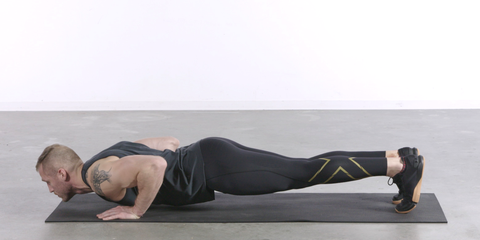The pushup is a strength training staple — but are you sure you’re even doing the exercise correctly?
For this basic gym necessity, you shouldn’t settle for anything other than perfect form—especially because it’s such a simple, essential movement. Let Men’s Health fitness director Ebenezer Samuel, C.S.C.S. and associate fitness editor Brett Williams guide you through the exercise’s subtleties, saving you from the bad habits that are keeping you from unlocking your fitness potential.
Before you drop down to give us any reps, take note that it’s extremely important to pay attention to the subtleties of the movement here. You’re not just flopping to the ground and pumping yourself up and down until you burn out—there are important aspects of the foundational plank position that you need to keep in mind every time.

Men’s Health
Own the Plank
Eb says: A pushup isn’t just a chest exercise. It’s a position of full body tension (or it should be). So start in a good plank: shoulders squeezed, glutes tight, abs tight. Check your form with this video guide to make sure you’re in the proper position.
Squeeze Your Shoulder Blades
Eb says: One of the most common pushup mistakes is trying to hollow out your back. You don’t want to do that. Doing so limits your ability to move your shoulders freely, and it’ll make the pushup a struggle. It can also lead to front shoulder issues, because every time you push up, you’re creating limited space for rotator cuff tendons to move between humerus and clavicle.
Think of squeezing a walnut between your shoulder blades as you lower into the pushup. Pull your torso to the ground, tightening those back muscles, then push up.
Hit the Bench
Eb says: The best regression for pushups isn’t knees on the ground. We see that a lot—and then we see people to struggle to evolve to the full pushup. That’s because you’re not training your glutes and core to properly stabilize.
Instead of doing starting your pushups on your knees, place your hands on a bench and gradually progress to using lower and lower benches (or whatever platform you have handy) for your hands. This will let you work with less load but still train core tension.
Source: Read Full Article
